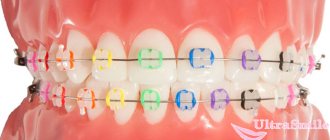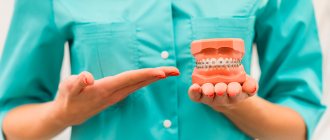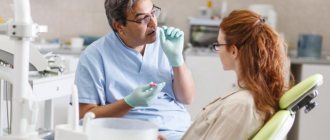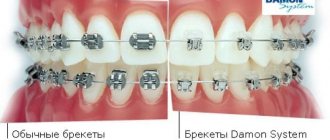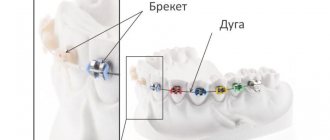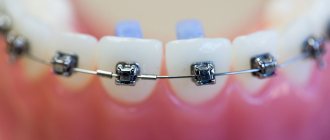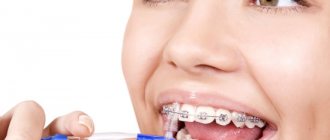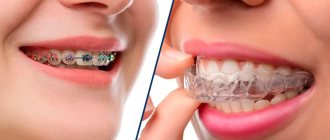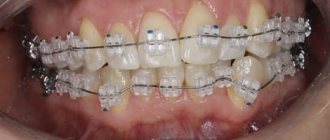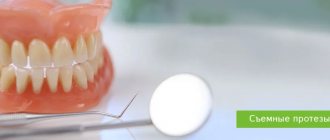Publication date: February 18, 2022.
Information on this page was updated on December 19, 2021.
For those who have not yet started orthodontic treatment, from the outside all braces may seem the same and differ only in material and aesthetics. In fact, modern orthodontic appliances come in a variety of designs. Some nuances of the lock-bracket design significantly affect the entire treatment process. It is the mechanism for attaching the arch to the bracket that self-ligating systems differ from ligature systems. In this article we will analyze in detail the principle of operation, design, all the pros and cons of self-ligating systems.
To understand the mechanics of how they work, you need to start with the basic design of braces. Any brace system (ligature or non-ligature, external or lingual) consists of small square brackets that are glued to the teeth. An arc made of metal with shape memory is fixed to them. The process of teeth straightening occurs because the arch, repeating the shape of an even dentition, is placed in the grooves of the braces and gradually returns to its original position, pulling the teeth along with it.
The traditional way of attaching the arch to the bracket slots is to fix it with ligatures - small elastic bands or wire rings. The arch is first placed in the recess in the middle of the lock, and then the elastic is put on 4 hooks around the perimeter of the bracket and holds the arch in the groove.
Self-ligating braces are a new generation of orthodontic systems - with a more complex bracket design, but without additional devices in the form of ligature rings. The bracket-lock in its device has a recess for the arch and a cover that securely closes the arch in the groove.
What are self-ligating braces?
For many years, classic ligature braces have been used to correct dental anomalies. They consisted of clasps glued to the teeth and a metal arch attached to them. The arch in such a system is attached to the clasps with ligatures - elastic rings or wire rings, and to the side teeth - with metal rings. The arch is fixed so that its traction helps straighten the teeth in the right direction. Ligature braces are still widely used today, but they require frequent visits to the doctor to correct the tension of the arch and change the ligatures (they quickly stretch and change color).
In the mid-90s of the last century, a new type of braces systems appeared - non-ligating or self-ligating. The difference between self-ligating braces and ligature braces is that instead of ligatures, they use special caps with clasps, through which an arch is threaded, like through channels. Getting rid of ligatures brought significant relief both to the orthodontist when installing braces and to the patient while wearing them. Currently, both ligature and non-ligature braces are used.
Differences between ligature and self-ligating braces
Main brands of self-ligating non-ligating braces
Popular brands of non-ligation systems include Damon, Clarity, Experience, In Ovation, H4.
Damon.
Perhaps the most famous brand of braces without ligatures. Its product line includes designs to solve any problems with bite and misalignment of teeth. The main advantage of these American systems is the damper mount developed by the company. It simplifies the archwire replacement process and reduces correction time.
Experience.
Japanese non-ligature designs, characterized by the small size of the clasps and their structure. Each clasp fits very tightly to the tooth enamel. Plus Experience controls the movement of each tooth.
Clarity SL.
Damon's main competitors. They are made of ceramic, but the groove in their clasps is made of stainless steel. This guarantees smooth sliding of the arc, as in metal systems. At the same time, they are classified as aesthetic systems, since they are invisible on the teeth. Treatment duration with Clarity SL is typically reduced by 25%. However, it all depends on the clinical picture.
In Ovation C.
These are ceramic non-ligature structures from the American company DENTSPLY. These systems are designed to prevent incorrect fixation. In Ovation C clasps are 100% protected from discoloration during wear - for this, the manufacturer coated them with a layer of zirconium dioxide.
H4.
Another self-ligating braces made in America. They are distinguished by a low profile of the locks and a minimum size of the groove for the orthodontic arch. Allows better control of treatment at the final stage.
Advantages and disadvantages of non-ligature systems
Self-ligating non-ligature braces have a number of advantages over classic ligature braces. They:
- thinner, more elegant, less noticeable;
- provide easier adaptation of the patient to them;
- are installed quickly, since there is no need to attach the arc separately to each lock, it is simply threaded through the caps;
- allow precise adjustment of the system taking into account the required trajectory;
- do not require frequent correction: you need to visit the orthodontist no more than once every two months, whereas after installing ligature braces - once a month or even more often;
- physiological, do not have a negative effect on periodontal tissues;
- reduce the duration of correction;
- do not require much maintenance effort compared to ligature ones (food debris gets stuck mainly in the ligatures).
The disadvantage of non-ligature self-ligating braces is their higher price compared to ligature ones.
Self-ligating and ligature braces - what are these systems and what are their differences?
- Ligature bracket system.
A ligature apparatus is a bracket system in which, in addition to the metal arch and the braces themselves, there is another structural element that performs a connecting function. This element is called a ligature. What it is?
The ligature can be made of metal or rubber and is located in the groove of each bracket-lock. It acts as a retainer for a metal arch that puts pressure on the teeth. That is, the design of the ligature brace system is a lock, an arch with shape memory and ligatures.
Such designs have a main drawback - the ligatures wear out quite quickly, become unusable and require periodic replacement. Otherwise, orthodontic treatment will lose its effectiveness.
- Self-ligating system.
In an attempt to correct the lack of ligature systems, non-ligature self-ligating dental braces were invented, which made the correction of abnormal bite more comfortable. Structurally, they differ in that instead of ligatures, they use special latches, which secure the metal arc to the clasps. The advantages of such clamps are obvious. Unlike ligatures, they do not deform over time, do not require replacement, and create minimal friction force. This allows you to wear ligature-free braces with greater comfort and less often visit an orthodontist for correction.
Both types of orthodontic appliances are highly effective, correcting the bite and straightening the teeth. But the self-ligating system has more advantages.
Types of self-ligating braces
Liature-free braces are divided into types according to their mechanism of action, material of manufacture and brands of individual manufacturers (brands).
By mechanism of action
Based on this feature, ligature-free braces are divided into two types:
- active – the cap (clip) exerts active pressure on the arc, forcing it to move in the desired direction;
- passive - the lid does not affect the arc in any way, it simply holds it in the lock; it is believed that this is a more natural type of correction that does not injure the periodontal tissues.
By material
Metal and ceramic self-ligating systems
Self-ligating braces are made from metal, dental ceramics and artificial sapphires. The strength and volume of the model, as well as indications for its use and aesthetics, depend on the material of manufacture.
Metal self-ligating braces
The most popular and reliable non-ligature models. Advantages:
- durable, reliable bracket systems, do not break, suitable for correcting any anomalies;
- easy to install and remove;
- cheaper than models made from other materials.
The disadvantages of metal structures include their low aesthetics: metal braces, even with the smallest locks, will always be visible when you smile.
Ceramic self-ligating braces
Also popular models are made of durable white dental ceramics in different shades. They are installed by patients who want to look more aesthetically pleasing. Advantages of metal self-ligating bracket systems:
- lighter and more comfortable to wear;
- you can choose the color of the locks exactly to match the color of your own teeth and they will be invisible, since they do not give glare;
- the adaptation period passes quickly, there is practically no discomfort or speech impairment;
- do not injure the soft tissues of the oral cavity.
Disadvantages of ceramic structures:
- more fragile compared to metal ones, sometimes they break and are not used for the correction of complex malocclusions;
- more expensive than metal ones;
- the metal arc is still visible when you smile.
Sapphire self-ligating braces
Made from transparent artificial sapphires, characterized by high strength and brilliance. Advantages:
- aesthetics - the reflection of light makes the metal arch less noticeable and gives the smile a radiance;
- stronger than ceramic ones, but inferior in strength to metal ones; therefore, they are used to correct some complex malocclusions, but still not all;
- do not have a negative effect on surrounding tissues.
Disadvantages of sapphire models:
- require more careful care, as they can quickly lose transparency due to plaque;
- the most expensive.
By brand
Global manufacturers are constantly improving their models and brand lines. Externally similar designs can differ significantly in their properties and correction efficiency. Below you can find the most popular brands of self-ligating braces.
Self-ligating Damon braces (Ormco, USA)
The Damon line of self-ligating braces is the most popular in our country. The designs are easy to use and reliable due to improved valves with locks, allowing you to quickly install and remove the system. Popular Damon (Daimon) models:
- Damon Q self-ligating braces - a comfortable and ultra-reliable design made from a hypoallergenic metal alloy, is very popular among orthodontists and their patients. A passive type of traction is used, which allows you to cope with any anomalies of the dentition in a shorter time compared to other systems. Small clasps help patients quickly adapt and do not cause them discomfort when wearing braces. The model costs a lot, but is cheaper than designs made from other materials;
- Damon Clear are aesthetic ceramic braces made of highly wear-resistant material based on aluminum. The improved locking shutter allows for quick installation and removal of the system. The model is reliable, but less durable than metal structures, so it is not used to correct complex malocclusions, and it is also very expensive.
Damon Q braces
Damon Clear braces
Clarity SL (3M Unitek, USA)
The company is a leader in the production of bracket systems: the Clarity SL model of self-ligating ceramic braces successfully competes with Damon Clear. Increased reliability of the design is provided by the use of metal to strengthen the channels (the arc passes through them) in the locks. The model is aesthetic and almost invisible on the teeth, but is not intended for the correction of complex anomalies. But its price is lower than that of Damon Clear.
Clarity SL braces
Experiense (GC Orthodontics, Germany)
German products are traditionally of high quality. Experience metal – self-ligating braces of high reliability due to clasps made of ultra-strong, non-oxidizing metal. They are cheaper than the Damon Q system, but are in no way inferior to it in quality, and are used to correct malocclusions of any complexity.
In Ovation (Dentsply, USA)
The In Ovation (Innovation) line from the American company Dentsply is also distinguished by its aesthetics and reliability. It includes models:
- In Ovation R are metal self-ligating braces with a special locking design that allows you to set the desired arch tension and distance between the locks. The design is very reliable and can be used to treat complex malocclusions;
- In Ovation C is a ceramic aesthetic model. The clasps are coated with zirconium dioxide to prevent discoloration. The design features of the model prevent its incorrect installation. These are high quality braces and are cheaper than Damon Clear.
In Ovation R braces
Self-ligating brackets H4 (Ortho Classic, USA)
H4 are high quality metal self-ligating braces made from fully biocompatible metal. Their special feature is the miniature clasps, located as close as possible to the gums, so that the h4 system is practically invisible when smiling. The system is comfortable to wear and does not irritate soft tissues.
H4 braces
Brand lines of Forestadent, Germany
The oldest German company presents a line of four self-ligating models:
- QuicKlear is a self-regulating ceramic design. A special feature is a metal flap with clasps for threading the arc. The flap is polished, has a matte color and almost does not differ from the locks in color, the locks are flat, their edges are rounded. They actively influence the arc, ensuring its movement in the desired direction. This is a reliable and beautiful model;
- TruKlear is an improved version, a ceramic self-ligating model with a ceramic lid. Special ceramics do not change its color, which is why the design is almost invisible on the teeth;
- BioQuick – active self-ligating ceramic braces with small clasps. A special feature of the design is the quick fixation of the locks with special protrusions on their base. The force holding the arc in the groove allows it to be moved in the desired direction;
- BioPassive – passive self-ligating ceramic braces. Passive action is achieved through a flexible cap and deep grooves that reduce arc friction. Effective correction is combined with a soft, non-traumatic effect on periodontal tissues.
What materials are ligature-free braces made from?
Locks for self-ligating structures are made from the same materials as for classic ligature braces - metal, ceramics and artificial sapphires.
Metal self-ligating braces
They are the easiest to install and remove. These durable, reliable systems correct all malocclusion pathologies and effectively move teeth into the desired position. Cheaper than designs made from other materials, therefore popular with patients.
Self-ligating ceramic braces
They are made from durable white dental ceramics in different shades, so they look more attractive than metal ones. The clasps of such systems are invisible, since the ceramics merge with the tooth enamel. The only noticeable detail is the orthodontic arch. They have one drawback - fragility compared to structures made from other materials.
Sapphire self-ligating braces
Like ceramic ones, they are almost invisible on the teeth. They are, of course, not made from natural sapphires - otherwise their price would be very high. During production, a transparent artificial material is used, the characteristics of which are identical to sapphires. They reflect light and make your smile really sparkle. Sapphire braces are more often used in the treatment of complex malocclusion pathologies; they are stronger than ceramic ones.
Indications for installation
Self-ligating braces are installed to correct the following anomalies:
- malocclusion - improper closure of teeth; metal models are used to correct complex malocclusions, which eliminates the need for surgery;
- curvature, uneven position, crowding of teeth or large gaps (three spaces) between them;
- unerupted (impacted) teeth – braces help to pull them out:
- disorders of the temporomandibular joint, causing difficult painful movement of the jaws, increased muscle tone;
- displacement of the dentition caused by prolonged absence of teeth, leading to facial asymmetry;
- to improve the appearance of the face in profile;
- in preparation for prosthetics or implantation to expand the gap between teeth, if the tooth has been missing for a long time and the gap has decreased.
The orthodontist decides together with the patient whether to choose self-ligating or ligature braces. The approach to selection should be individual, taking into account the characteristics of the existing pathology, aesthetic preferences and the cost of the design. Ligature-free braces are more expensive and do not require frequent visits to the doctor, so they are more often installed on adult patients. Children (not earlier than 8–9 years old and only on permanent teeth) and adolescents can have both types of braces installed, but they are still more often fitted with metal ligature models. Read more about braces for children here.
Ceramic and sapphire models are not suitable for children, as they are quite fragile and can injure a child if broken.
Models of braces in the Damon line
Damon Clear is just one type of Damon braces, there are others. Today, the line of Damon braces includes only 4 types:
Damon Q
Diamond Q braces are classic vestibular non-ligature braces. This type of braces is made of metal. Damon Q differs from other classic systems in its reduced size of locks, compactness, and strength. These braces allow you to achieve results even in the most difficult cases. Among the entire Damon line, this type of braces is the most affordable.
Damon 3 MX
This bracket system is self-ligating and is particularly durable. The strength of the structure is determined by its manufacture from steel.
Damon 3
It is a combined bracket system. Combines such qualities as reliability, functionality and aesthetics. Aesthetics are achieved through the use of special ceramic inserts that are practically invisible.
Damon Clear
The most expensive, but also the most innovative braces in the Damon line.
They are highly aesthetic. They are completely transparent, which makes them invisible on the teeth. It is Damon Clear braces that are discussed in this article. A distinctive feature of Damon bracket systems is the ability to use them in particularly difficult cases. If there are serious defects in the teeth, they usually have to be removed before installing standard braces. Damon systems allow you to save teeth and often only separation can be done.
Contraindications
The installation of self-ligating structures also has contraindications. They can be absolute (correction is never carried out) and relative (correction can be carried out under certain conditions or after some time).
Absolute contraindications include:
- some common diseases that lead to decreased immunity and increased risk of infection of periodontal tissues - diabetes mellitus, immunodeficiency, blood diseases, cancer;
- severe chronic infections - AIDS, open tuberculosis;
- mental illnesses that prevent the patient from contacting the orthodontist, epilepsy;
- changes in the bone tissue of the jaw (atrophy, osteoporosis) - a thinned bone may not withstand the load;
- the absence of several teeth in the dentition at once - treatment should be carried out by an orthodontist together with an orthopedist.
Relative contraindications:
- infectious and inflammatory diseases of the oral cavity, teeth and periodontal tissues - stomatitis, caries, periodontitis;
- degenerative-dystrophic periodontal diseases - periodontal disease;
- the presence of implants and fixed dentures in the dentition - the issue of installing braces should be decided by the orthodontist together with the orthopedist;
- bruxism – grinding of teeth, mainly during sleep;
- allergies to dental materials – selection of materials will take some time;
- pregnancy and lactation;
- any acute diseases and exacerbation of chronic diseases.
Clinic doctors
DentaBravo dental clinic offers its patients orthodontic treatment using self-ligating (ligature-free) brace systems. These aesthetically pleasing, effective, non-invasive devices provide excellent results in a relatively short time.
What are self-ligating braces?
Self-ligating brace systems are orthodontic devices, the design of which does not contain ligatures (additional rubber rings that attach the arch to the braces). The elements of the system are fixed with special clip-latches located on the braces. Thanks to this structure, the arch is fixed, but not blocked, so less physiological forces are required to move the teeth. This operating principle of self-ligating braces makes the process of dentition correction more comfortable.
What are the features of self-ligating braces?
The main feature of such brace systems is that the correction of bite and uneven teeth is carried out with the participation of the muscles of the cheeks, lips, and tongue; the desired result is achieved much faster and is maintained for a long time. In addition, the design of this device greatly simplifies and speeds up the installation of braces on the teeth, as well as changing the arch and correcting the device.
What are the advantages of self-ligating braces?
The advantages of ligature-free braces include:
- Aesthetic appearance – clip-type fasteners look more attractive than rubber rings and wires.
- Quick adaptation - thanks to low pressure, unpleasant sensations are minimized, and teeth and gums adapt to the device in a short time.
- Relatively short terms of orthodontic treatment - the self-ligating brace system is characterized by minimal friction, which shortens the period of bite correction.
- Relatively easy to care for: the absence of ligatures makes brushing your teeth easier.
- Ability to quickly install and remove equipment.
- Spending less time on replacing the power arch - self-adjusting braces are easier to adjust.
- Safety for the patient’s health – the system does not injure the mucous membranes of the oral cavity and does not have an aggressive effect on gum tissue, therefore it can be installed even in patients with periodontal tissue diseases.
- Correcting a bite with self-ligating braces does not require the removal of healthy teeth that interfere with the alignment of the dentition with traditional ligature systems.
What are the disadvantages of self-ligating braces?
To date, no disadvantages of self-ligating (self-regulating) braces have been identified. A relative disadvantage of these systems is the rather high cost, which is due to a more complex device compared to traditional versions of orthodontic appliances. However, the benefits of using them more than pay for the high costs.
Indications
Indications for treatment with non-ligature braces are the same as for the use of conventional systems. They come in two plans:
- The patient has functional disorders in which malocclusion or uneven position of individual teeth negatively affects the body:
- dysfunction of the mandibular joint;
- poor quality of chewing food, causing gastrointestinal diseases;
- deterioration of the gum tissue.
What kind of ligature-free braces are there?
Self-ligating braces are distinguished by material, and they are:
- Metal. Devices made of various metals (medical steel, silver and even gold) are considered the most reliable and effective. Being very durable, they have the lowest coefficient of friction and excellently withstand heavy loads. Metal non-ligature braces can correct the most severe dental anomalies. However, they have a serious drawback - such systems are clearly visible in the oral cavity. Those for whom aesthetics are important need to choose a different material or install a lingual orthodontic device. Installed on the back surface of the teeth, metal non-ligature braces will not be noticeable to others at all.
- Ceramic. Ceramic systems look more attractive, since when creating the plates, the shade of the patient’s teeth must be taken into account. Such devices are also very durable, and their coefficient of friction is low. The downside of such systems is the fairly high cost - treatment using non-ligature ceramic braces will cost more than correcting a bite with a metal system.
- Sapphire. These orthodontic devices are considered the most aesthetic, because their plates are made of transparent material - synthetic monocrystalline sapphire. Such braces practically do not stand out against the background of the teeth. In addition, this material is quite durable, resistant to food dyes and hygienic. The cost of ligature-free sapphire braces is higher than that of ceramic-based systems.
Depending on the place of installation, orthodontic systems without ligatures are of two types:
What is the cost of self-ligating braces?
You can find out the cost of non-ligation and other types of brace systems at the DentaBravo dental clinic on the corresponding page of this website or in the table below. To schedule a consultation with our specialists, click on the “Submit Application” button and fill out a simple online form. An orthodontist will perform a diagnosis and offer options for correcting the bite using non-ligature ceramic braces, metal systems or artificial sapphire.
Installation of self-ligating braces
When making an appointment with an orthodontist in the clinic, the patient must be asked for consent to the processing of personal data. The installation of any braces system consists of several stages: diagnosis, treatment of the identified pathology and the actual installation of braces.
Diagnostics
To install a bracket system, you must first make sure that there are no contraindications for this procedure. During the consultation, the orthodontist carefully examines the patient and then sends him for an additional examination: a survey radiography of the upper and lower jaw to identify bone tissue pathology. If necessary, a computed tomography (CT) scan of the jaw and magnetic resonance imaging (MRI) of the temporomandibular joint are performed, and a referral is made to a dentist-therapist. The therapist examines the oral cavity, identifies caries and inflammatory gum diseases.
Treatment
All identified pathologies are treated: carious teeth, stomatitis. If necessary, damaged teeth are removed. Periodontitis and periodontal disease are treated to a state of stable remission. This is followed by professional teeth cleaning and polishing.
Installation of non-ligature systems
The orthodontist installs a mouth opener, cleans and dries the teeth. After this, step by step:
- glues a lock to each tooth using special dental cement; for final fixation, the adhesive-cement is treated with ultraviolet rays, and its remains are removed; Most often, the structure is installed first on one jaw - the upper one, and after 2 weeks - on the lower one - this makes adaptation easier;
- when the cement has completely hardened, an arc is pulled through the grooves of the locks and each lock is closed with a lid; they snap tightly and securely hold the metal arc; the structure is secured on the sides with rings on the chewing teeth, most often 6 or 7.
During installation, the patient does not experience pain. The entire procedure for installing self-ligating braces lasts about an hour. You will need to visit the orthodontist once every 2 months to monitor and adjust (activate) the system.
Self-adjusting braces price
The cost depends on the level of the clinic, the material used and the complexity of the clinical case. As already mentioned, non-ligation brace systems are much more expensive than traditional analogues, so the price for metal models will vary from 30,000 rubles, and for ceramic ones from 35,000 rubles and can even reach 100,000 rubles. Please note that these are amounts for one jaw. If a brace system is needed on both jaws, the only way to save money would be to install ceramic braces on the upper jaw, as they are more noticeable, and metal ones will be installed on the lower jaw, since this will not affect the quality of the work.
Caring for self-ligating braces
Non-ligature braces are easier to care for than ligature braces, as food is less likely to get stuck in them. But careful care is necessary, otherwise bacterial plaque will form on the teeth and caries will begin. To prevent this from happening, you need to maintain oral hygiene:
- brush your teeth twice a day with a special V-shaped toothbrush;
- After each meal, even after drinking juice or milk, rinse your mouth thoroughly; If there are food particles left in the teeth, they can be removed with a stream of water from an irrigator or using an interdental brush.
You should also follow the nutritional recommendations:
- in the first week after installing the system, you need to eat soft food, then gradually switch to harder food; but foods such as nuts and seeds will need to be excluded;
- limit the consumption of sweets and sugary drinks - this is an excellent breeding ground for bacteria;
- You should not eat foods that stick to your teeth – chewing candies, chewing gum.
Popular metal models - cheap
Structures can be made from various materials. The cost of treatment depends on them. Most often, patients choose metal structures, since this material is distinguished by its reliability and low price. Metal structures help correct bite even in the most difficult clinical cases.
Metal
Their main disadvantage is their lack of aesthetics, but this is compensated by their efficiency and durability. Today, such structures can be installed even for patients with allergies, since only hypoallergenic alloys are used in their manufacture.
Let's introduce popular self-ligating, non-ligating systems made of metal.
Damon 3MX. It is one of the most effective. The design has no sharp corners, so the process of getting used to it is as quick and comfortable as possible.
Damon 3MX
Damon Q. Can be used to treat complex cases, including distal, mesial occlusion and dental dystopia. They are customized individually for the patient and allow you to avoid tooth extraction, reducing the treatment period by 20%.
Damon Q
Smart Clip. Their feature is a unique patented snap mechanism. It allows you to control the arc strength, providing maximum therapeutic effects.
Smart Clip
In-ovation R is compact. The latches have an additional impact on the arc, and this shortens the treatment period.
In-ovation R
A self-ligating metal brace system can cause irritation on the gums and mucous membranes, just like any other model, if the patient’s oral hygiene is poor. It differs only in lower cost and better visibility for others.
Possible complications
With proper installation, there are practically no complications, but in the first 1 - 2 weeks unpleasant symptoms may appear:
- discomfort in the oral cavity; with non-ligature models, which are small in size, this goes away quickly;
- speech impairment - disappears within 2 - 4 weeks; to speed up the process, you need to talk and read aloud more;
- dry lips – this symptom may bother you during the entire period of wearing braces; it can be reduced with the help of special moisturizing cosmetics;
- pain in the teeth - if the surrounding soft tissues are not inflamed, then this is due to the movement of the teeth in the desired direction; after some time, the tissues adapt to the impact, and the pain goes away;
- pain associated with irritation of the gums, tongue and inner surface of the cheeks; to prevent inflammation from developing, it is recommended to rinse your mouth with antiseptic solutions - infusion of chamomile flowers, calendula, Miramistin; over time all this passes;
- headaches - they are not so common, but sometimes wearing braces provokes their appearance; in such cases, you need to visit an orthodontist, make sure that the system is installed correctly, and then contact a neurologist.
Urgent medical attention is required if the following symptoms appear:
- redness, swelling of the gums, the appearance of ulcers in the mouth with an increase in body temperature, loosening of teeth, increasing pain - these signs appear as a result of improper installation of the system;
- the appearance of carious spots on tooth enamel.
Damon product lines
Depending on their design and materials of manufacture, Ormco products are divided into the following categories:
- Damon Clear.
They contain polycrystalline aluminum - a unique substance, thanks to which stains do not appear on the tooth surface and the enamel does not darken. Patients with such braces can eat colored foods and drink coffee and tea without restrictions. This is an extremely important point, because after wearing ligature models, many clients are left with clearly visible marks on their front incisors. These enamel damages are noticeable when talking, smiling and eating, and to eliminate these defects, whitening will be required, which will put even more unwanted stress on the enamel. Patients with Damon systems will be free from such problems.
- Damon Clear 2.
This model is also made on the basis of polycrystalline aluminum and does not impose restrictions on the patient’s diet. However, there is another significant advantage: braces in this category are transparent, which means they are almost invisible in the mouth. With the help of 3D technologies, the orthodontist will be able to produce a system that will take into account the specific structure of the client’s oral cavity down to the smallest nuances.
- Damon 3.
These are ceramic non-ligature models that are characterized by minimal weight and dimensions. Their presence in the mouth is almost not felt, and they do not at all interfere with blood circulation. If you are afraid that braces will scratch your cheeks from the inside, then with Damon 3 such a problem will definitely not affect you.
- Damon 3 mx.
This model is characterized by increased strength and rounded shapes of all components. It is recommended for patients with sensitive mucous membranes, because it is guaranteed not to injure them. You will be able to move your tongue over any elements completely calmly.
- ● Damon Q.
These braces are extremely miniature and do not cause any inconvenience to the client. Their advanced Spin Tek latches feature sliding doors, making system adjustments even easier. Damon Q braces also have additional horizontal and vertical grooves.
During your initial examination, your orthodontist will explain which braces are best for you and how long you will need to wear them. Please note that of all the methods of bite correction available today, Damon is recognized as the most physiological - it is unlikely that you will be able to find a more aesthetic and less traumatic option.
ATTENTION:
Damon sapphire braces are called that not because they are made of precious stone. The system is made from ceramic, but since it is transparent and invisible in the mouth, it is figuratively compared to sapphire.
How much does it cost to install ligature-free braces?
The cost of installing self-ligating braces consists of:
- cost of examination and preliminary treatment;
- the orthodontist’s work on installing the structure;
- prices of braces depending on the brand;
- geographic location and reputation of the clinic.
Approximate prices for different brands of non-ligature braces for one jaw:
- Damon Q: 27–50 thousand rubles.
- Damon Clear: from 60 thousand rubles.
- In-Ovation R: 40 thousand rubles.
- In-Ovation C: from 45 thousand rubles.
- Activation of a self-ligating brace system from RUB 2,800.
The main advantages of self-regulating bracket systems
A distinctive advantage of braces is the use of small physiological forces. According to reputable doctors and other specialized specialists, this approach makes it possible to significantly reduce the trauma of the entire process of occlusion correction and can reduce treatment time by 25%.
Some self-ligating braces allow for more individualized correction, as it is possible to program the bracket system for how each tooth should be positioned. This makes the process of moving teeth much more predictable, and the result optimal.
A huge variety of such brace systems makes it possible to choose exactly the one that is best suited in each individual case. For people who value maximum functionality rather than aesthetics, orthodontists recommend durable self-ligating metal braces. And ceramic bracket systems are perfect for people who are accustomed to giving preference to aesthetics. However, there are also compromises: the same non-ligature braces, which ideally combine the strength of steel and the aesthetics of ceramics.
Advantages of using ligature-free braces
- Self-adjusting braces do not have hooks and take up very little space in the mouth. This significantly reduces adaptation time and makes oral care easier.
- Also, ligature-free braces are the only method of teeth straightening that can be offered by a doctor to a patient with periodontal disease.
- During the installation of self-ligating braces, the patient can avoid wasting his time and come for an appointment once every 3 months.
- The arc change time, thanks to the clamps, takes 10-15 minutes.
- Well, the main difference between self-ligating braces and ligature braces is that teeth are straightened with the help of the muscles of the tongue, cheeks and lips, and a positive result is achieved faster and lasts for a long time.
- Ligature-free braces apply little pressure on the oral mucosa, resulting in a reduction in trauma to almost zero.
- To successfully continue treatment, it is enough to rarely visit the doctor once every 2-3 months.
- They are made from proven and pure materials that do not interact with the environment in the oral cavity.
- The absence of ligatures in such brace systems greatly simplifies oral care for patients.
- Patients wearing such braces quickly get used to them due to their optimal size.
- When correcting your bite, you will not have to remove teeth.
- The alignment process is calculated for all teeth separately.
- Their design guarantees continuous operation of the archwire, which is why you do not have to go to a specialist to activate your braces. This is very important for patients who do not have enough time to visit the dentist.
- Self-ligating braces have a pleasant appearance.
- Removal and installation of the structure takes place as quickly as possible.
Invisible ceramic and sapphire systems
No less effective are ceramic braces, which are made from durable ceramics. Most often, systems made from such material are installed in adult patients, since they are practically invisible on the teeth and cause minimal psychological discomfort.
The advantages of ceramics include the following:
- Resistant to various types of influence: mechanical, thermal, chemical.
- The color is matched to the tooth enamel.
- Used for long-term treatment.
- Do not negatively affect tooth enamel.
- They have a smooth surface with rounded corners and do not damage the mucous membrane.
Treatment with such braces will take a little longer; orthodontists often recommend them to correct minor bite problems. There are many different models of ceramic systems. The most popular are the following models.
Clarity SL. These staples are made using aluminum oxide materials, so they are quite durable and relatively transparent. This model is the only system in which only the grooves are metal.
Clarity SL
In-Ovation C. Their base is reinforced transparent ceramic. Additionally, it is coated with a layer of silicon oxide, so the system looks quite attractive and is popular with orthodontists.
In-Ovation C
3 Damon. Self-ligating braces are practically no different from the metal counterpart Damon 3MX. The only difference is the presence of ceramic elements in the design, due to which the system looks less noticeable on the teeth.
3 Damon
Damon Clear (ORMCO). Such self-ligating non-ligating braces are invisible on the teeth, since they are made from polycrystalline sapphire. This model is not painted. The only drawback is the high price.
Damon Clear
Sapphire non-ligature braces are made on the basis of artificial stone. The advantage of this material is its natural shine and transparency. They do not stain or fall out. The course of treatment with such staples is longer. In some cases, an allergic reaction may occur.
There are also plastic designs that are a budget analogue of ceramic and sapphire ones. To create them, safe hypoallergenic plastic is used. The disadvantage of plastic systems is strong staining from food and drinks. Plastic itself is a fragile material, so orthodontists have not used them for a long time.
